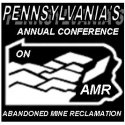Three people who have cleaned streams and lakes in Northeastern Pennsylvania told students on Martin Luther King Jr. Day that volunteers can improve the natural world.
Ed Wytovich said he wanted to volunteer since boyhood when his friend pointed to a pretty spot along a polluted stretch of river where they played and said: “I’ll bet in 30 years when they fix it up, we’ll be could go fishing.”
It took 40 years, but trout now live along that stretch of the Little Schuylkill River in Port Carbon, said Wytovich, who started a group to remove polluted mine drainage from the Catawissa Creek.

Ed Wytovich of the Catawissa Creek Restoration Association shows photos of the work being done at the creek to a group of Hazleton Area High School students in Shawn Darraugh’s employability skills class during session on environmental stewardship inspiring a new generation to engage in volunteer service to honor Dr. Martin Luther King’s legacy, The program was sponsored by the Greater Hazleton Area Civic Partnership and held at the Greater Hazleton Chamber of Commerce on Monday. ERIC CONOVER/Staff Photographer
Charlene Wildes missed the woods near where she grew up when she moved to the suburbs so she volunteered at a nature center. Later, she got a job there.
“When you volunteer you always get back more than you give,” said Wildes, who now works at the Lacawac Sanctuary in Lake Ariel, Wayne County.
John Levitsky of the Luzerne County Conservation Association said students can improve streams by planting trees along the banks. The trees shade the water, keeping temperatures cool enough for trout. Insects that fall off the leaves become food for fish, and the tree’s roots absorb water and prevent soil from washing into the creek after storms.
Shawn Darraugh brought his students from the employability skills class at Hazleton Area High School to learn from Wytovich, Wildes and Levitsky at the Greater Hazleton Chamber of Commerce.
The lessons will give the students perspective later in the year when they volunteer to help maintain the Hazleton rail trail.
Bob Skulsky, who runs the Greater Hazleton Rails to Trails Association from the chamber’s office, also joined the program. He told students that trout live in a stream that follows the new section of trail, even though the area contains mine spoils.
Don’t judge a stream by its color, Wytovich said.
Streams that are orange from iron washing out of coal mines support trout, even though the iron forms armor on the creek bottom and kills insects on which the trout feed.
“What we don’t know is how the food web develops,” he said.
Stretches of the Catawissa Creek, meanwhile, look blue as tropical waters, a sign that they might contain aluminum solutions, which gum up the gills of fish and prove deadly.
Wytovich showed photos of places along the Catawissa and in Eagle Rock Resort, where his group treats water with limestone.
The limestone makes the water less acidic and allows aluminum to precipitate into a white substance that isn’t fatal to trout, which perish when water dips below about 4.5 on the pH scale.
Even the rain and snow that falls on Northeastern Pennsylvania is acidic enough to harm fish.
Levitsky said he has sprinkled limestone on roads at stream crossings to raise the pH of Bowman’s Creek, which isn’t near mine sites. The rain’s pH, however, has improved from 4.3 to 4.8 in the past 15 years or because of air pollution controls on power plants, he said.
Levitsky hopes an entrepreneur can clean streams polluted by mine run-off by reclaiming and reusing metals like aluminum, iron and manganese that now enter the water.
Wildes suggested that students “go to a stream and flip some rocks.”
The number and species of insects that they find under the rocks will suggest whether the stream is healthy.
She also brought pelts, skulls, scat and even a deer hoof to introduce the students to animals that Skulsky said live along the rail trail.
“It wouldn’t exist in nature if it didn’t have a purpose,” Wildes said while showing differences between the skulls of predators and prey.
Deer have eyes on the sides of their skulls to see predators approaching and square teeth for eating plants. Conversely, coyotes look straight at their prey from eyes in the center of their skulls, and rip meat with jagged canine teeth.
Beavers have a gap behind their huge front teeth that allows room for them to carry tree limbs, which they preserve in mud during the fall so they and their young will have leaves to eat in winter.
Jacen Sterling, an 11th grader, said he was impressed by how much the condition of the water affects trout and the surrounding “chain of animals” that survive in a creek.
He said the session encouraged him to “protect the water and not dump into it.”
kjackson@standardspeaker.com












